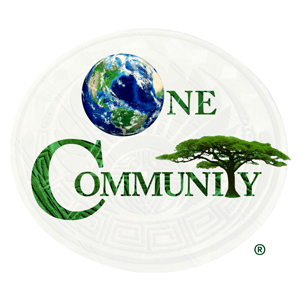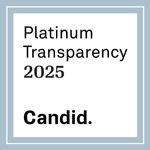Creating a Sustainable World That Benefits Everyone – One Community Weekly Progress Update #660
Posted on November 10, 2025 by One Community Hs
Leave a Comment
At One Community, we are creating a sustainable world that benefits everyone through freely shared solutions that make sustainable living achievable for all. Our all-volunteer team combines food, energy, housing, education, economics, social architecture, and fulfilled living into a replicable, self-sustaining model. By providing complete access to our processes and plans, we cultivate a global collaboration of teacher/demonstration hubs, regenerating our planet and evolving sustainability—for The Highest Good of All.
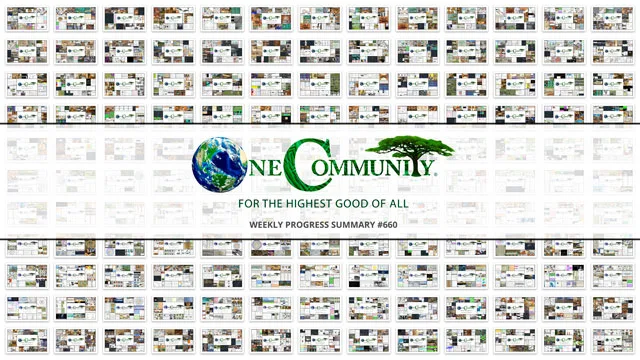
OUR MAIN OPEN SOURCE HUBS
Click on each icon to be taken to the corresponding Highest Good hub page.
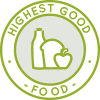

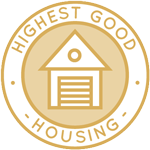
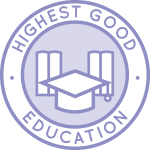
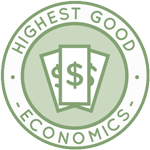

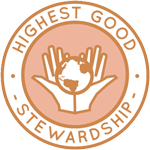
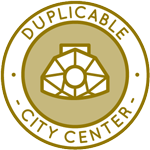
One Community’s physical location will forward this movement as the first of many self-replicating teacher/demonstration communities, villages, and cities to be built around the world. This is the November 10, 2025 edition (#660) of our weekly progress update detailing our team’s development and accomplishments:
Creating a Sustainable World That Benefits Everyone
One Community Progress Update #660
DONATE | COLLABORATE | HELP WITH LARGE-SCALE FUNDING
CLICK HERE IF YOU’D LIKE TO RECEIVE AN EMAIL EACH WEEK WHEN WE RELEASE A NEW UPDATE
YOU CAN ALSO JOIN US THROUGH SOCIAL MEDIA










ONE COMMUNITY WEEKLY UPDATE DETAILS
HIGHEST GOOD HOUSING PROGRESS
 One Community is creating a sustainable world that benefits everyone through Highest Good housing that is artistic and beautiful, more affordable, more space efficient, lasts longer, DIY buildable, and constructed with healthy and sustainable materials:
One Community is creating a sustainable world that benefits everyone through Highest Good housing that is artistic and beautiful, more affordable, more space efficient, lasts longer, DIY buildable, and constructed with healthy and sustainable materials:
This week, Ajay Adithiya Kumar Elancheliyan Tamilalagi (Mechanical Engineer) continued working on the ventilation system design for the Vermiculture Toilet component of the Earthbag Village. He edited Rahul’s model and drawer assembly and forwarded the updated design to Karthik for continuation of the simulation work. He also focused on the ventilation system report for the vermicomposting eco-toilet project, finalizing the Bill of Materials and compiling the results of the previously completed FEA and CFD analyses. The report included final material selection, figures, and organized sections detailing the duct design, filtration layout, support structure, and performance evaluation. All content was refined and formatted for inclusion in the final documentation submission contributing to creating a sustainable world that benefits everyone. Below, you’ll find some images of this work.
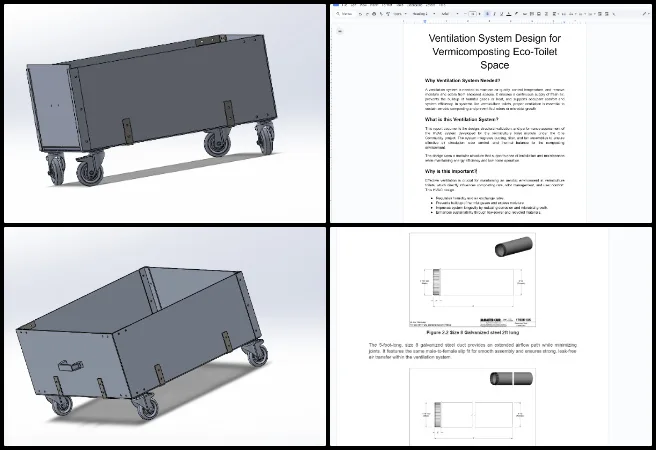
Baraka Minja (Civil and Environmental Engineer Pr. Eng.) continued working on the Communal Eco-shower and Vermiculture Toilet drawings. This week he added additional details and redboxing to the communal shower drawings to improve clarity and coordination. He also developed a concept for connecting the Duplicable City Center geodesic dome structure to its foundation, aiming to simplify construction and enable replication across multiple sites. The approach considered structural stability, ease of assembly, and material compatibility—further advancing efforts toward creating a sustainable world that benefits everyone. See below for some of the pictures.
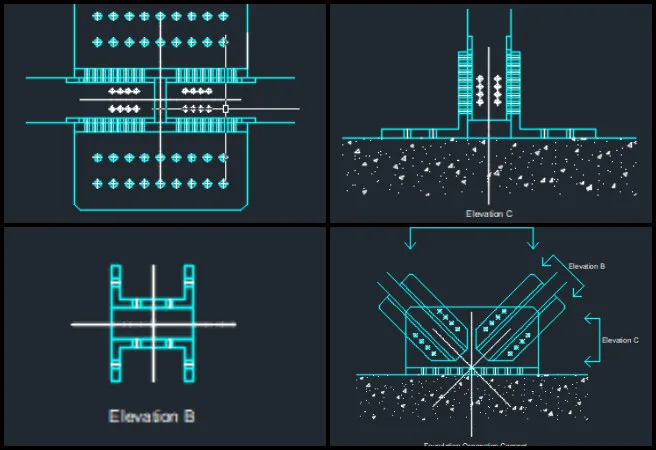
Derrell Brown (Plumbing Designer) continued working on the Earthbag Village 4-dome home final MEP report by reviewing feedback from the initial draft and implementing updates across multiple sections. He reviewed the Beautiful Tables Templates and image guidelines from the One Community Standards to align the report formatting with current expectations. The revisions included updating the Electrical Demand Values and WSFU Load Values to match current design guidelines and verifying the related hand calculations for accuracy and clarity. He also added introductory descriptions to tables and images throughout the report to provide clearer context for each data set and visual reference, supporting creating a sustainable world that benefits everyone. See below for some of the pictures related to this work.
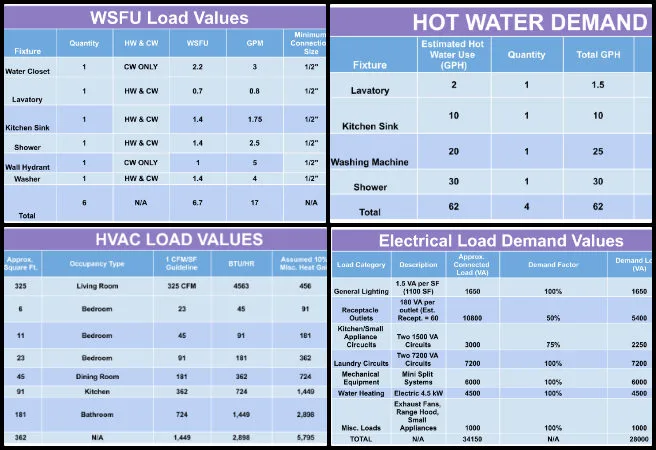
Fangting Xu (Interior Design Intern) continued working with ADA codes related to building connections for ADA 3-dome cluster of the Earthbag Village. This week, she drew four elevations and three sections for the 3 Dome Cluster ADA project by referencing the CAD files of 4 dome cluster. Fangting also followed up on Ananya’s offboarding documents. In addition, Fangting contacted Baraka to schedule the weekly meeting. Her organizational and technical efforts contribute to creating a sustainable world that benefits everyone. Below, you’ll find some images of this work.
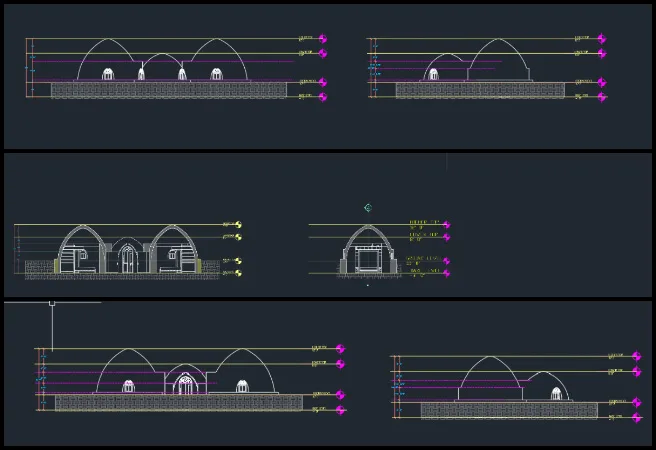
Karthik Pillai (Mechanical Engineer) continued work on the Vermiculture Toilet and 4-dome home components of the Earthbag Village. This week, he focused on refining multiple ongoing design projects. For the four-dome cluster roof design, he revised the project report in accordance with Jae’s feedback, incorporating the requested modifications to ensure technical accuracy and clarity. The updated report was resubmitted to Jae for an additional round of review. In parallel, Karthik worked on the vermiculture toilet project, where he integrated Rahul’s new drawer design into the existing model, finalizing the overall design configuration. Following the completion of the design phase, he prepared the associated report documentation and submitted it to Jae for an initial evaluation. Additionally, Karthik shared the completed Unistrut assembly with the team and initiated report preparation. His mechanical and documentation updates continue creating a sustainable world that benefits everyone. The related visuals are shown below.

Malhar Solanki (Mechanical Engineer) continued working on the Vermiculture Toilet component of the Earthbag Village. This week his work focused on advancing several key components of the composting drawer system project. The Bill of Materials (BOM) for the composting drawer systems was completed. Additional efforts were directed toward assisting Karthik with report writing, specifically contributing to the dumping system section. The basic outline of the BOM was finalized for dumping system, and several sections were completed as part of the documentation and report preparation. His collaboration and detailed planning play an essential role in creating a sustainable world that benefits everyone. Review the latest updates in the images below.
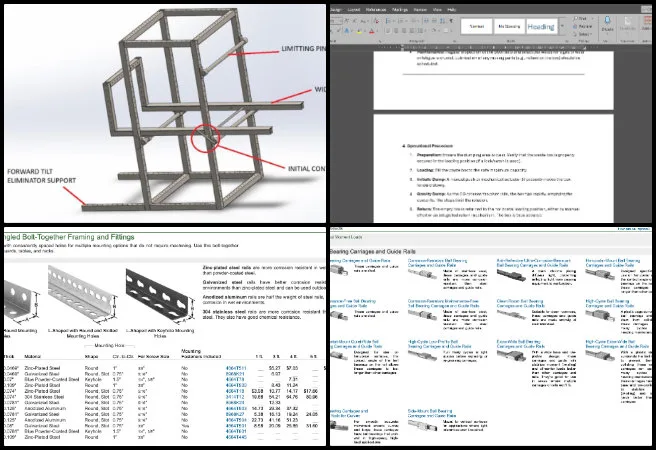
Michaela Silva (Architect) continued developing details in the construction documents for the
Earthbag Village 4-dome home. This week she completed putting the code requirements in the project documents and added a second code sheet. She updated the front door header elevation detail by modeling and incorporating additional framing between the door and the transom. She also placed the soffit plan detail on the ceiling plan sheet A404, further creating a sustainable world that benefits everyone. Check out the construction detail visuals below.
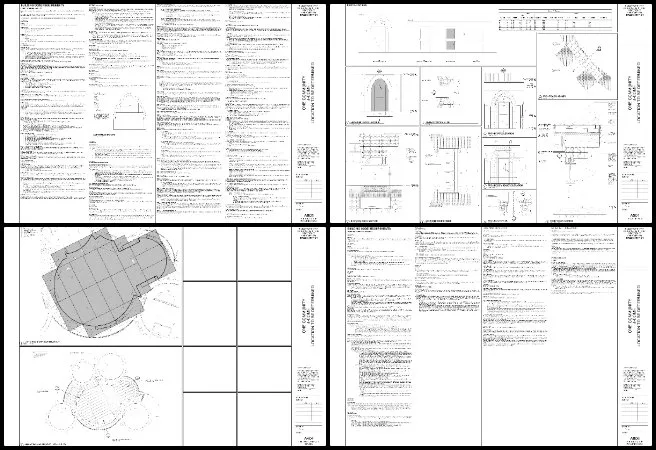
Rishi Chakrapani (Mechanical Engineer) continued working on the
Vermiculture Toilet. This week, the report was updated, formatted, and uploaded to the WiP collaboration document in accordance with the provided formatting guidelines. The report was also revised to include the FEA for the bolt analysis, addressing a critical point of failure identified on the winch that was evaluated further. Additional checks were performed to confirm that the formatting and references aligned with the team’s standards, and all findings were documented to maintain consistency across the collaboration file. His systematic documentation supports creating a sustainable world that benefits everyone. See below for some of the pictures related to this work.
DUPLICABLE CITY CENTER PROGRESS
 One Community is creating a sustainable world that benefits everyone through a Duplicable and Sustainable City Center that is LEED Platinum certified/Sustainable, can feed 200 people at a time, provide laundry for over 300 people, is beautiful, spacious, and saves resources, money, and space:
One Community is creating a sustainable world that benefits everyone through a Duplicable and Sustainable City Center that is LEED Platinum certified/Sustainable, can feed 200 people at a time, provide laundry for over 300 people, is beautiful, spacious, and saves resources, money, and space:
This week, Anjana Reddy Chittireddy (Architectural Designer) continued working on the Duplicable City Center external renders. This week she was focusing on the initial layout and design development of the front area landscape of the City Center project. She also worked on making corrections to the previous task, updating files as needed to ensure all revisions were incorporated and aligned with the project requirements. This open source Duplicable City Center project contributes to creating a sustainable world that benefits everyone. Explore the landscape visuals in the image below.
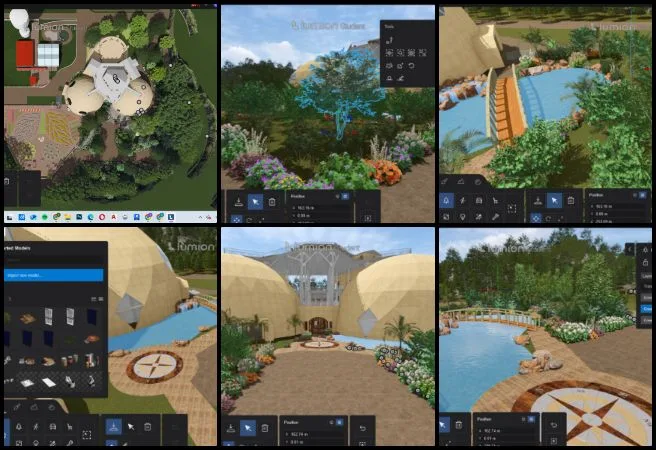
Ariana Virginia Gutierrez Doria Medina (Industrial Designer) continued working on the Duplicable City Center window and door framing by modifying the components and reassembling the 3D CAD window designs. With these modifications, the small gaps that could affect heat retention inside the structure were closed. She also updated the design of a stable support frame to securely hold the insulation material in place and improve the overall energy efficiency of the system. This open source Duplicable City Center project demonstrates creating a sustainable world that benefits everyone. See the presentation and research highlights below.

Ayushman Dutta (Mechanical Engineer) continued working on the City Center Dome Hub Connector Engineering and DIY manufacturing. This week he worked on the assembly instructions and made formatting corrections to improve clarity. He continued working on the cutting sheet document and had a meeting with the team to discuss the current and next action items related to the cutting sheet. He made formatting changes to the assembly process document and refined the cutting sheet, updating formatting and assembly drawings. He continued correcting the assembly process document and integrated the manufacturing process document into the main file, making the required updates to finalize the documentation. This open source Duplicable City Center project demonstrates creating a sustainable world that benefits everyone. Review the connector analysis visuals below for more details.

Bevan Chiu (Mechanical Engineer Volunteer) continued his work finishing the City Center Eco-spa Designs. This week he was working on updating the foundational CAD model to reflect Sandesh’s steel frame concept, including the integration of cinder blocks and rockwool insulation panels at the base of the tub structure, and adjusted component placement to align with the frame layout. He also reviewed and updated the relevant California spa requirements on the “Spa Test Tracker” sheet, referencing Chapter 31B: Public Pools from the California Building Code. This open source Duplicable City Center project contributes to creating a sustainable world that benefits everyone. For more details, refer to the image below.
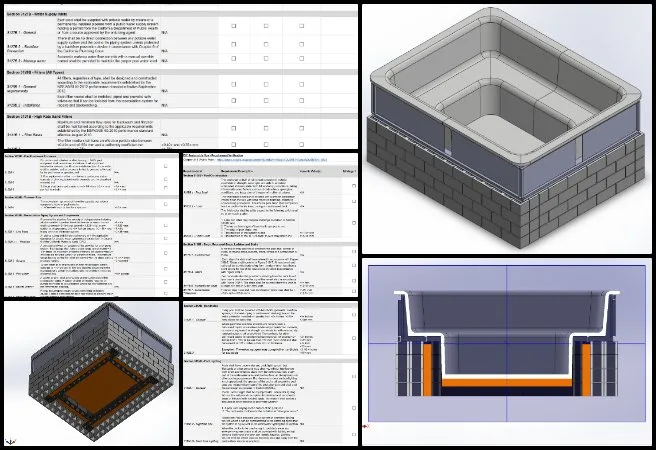
Sandesh Kumawat (Mechanical Engineer) continued developing the City Center Eco-spa Designs. He did this by developing a hybrid structural thermal CAD model that combines a steel frame load path with cinder block walls and Rockwool insulation, moving the concept to a verifiable assembly. He defined the steel members (C-channel or rectangular tubing) to carry full water and occupant loads, integrated cinder blocks and semi-rigid mineral wool batts (targeting ≥ R-4.0/in) as a non-proprietary, DIY-replicable envelope, and modeled the interior shell contours. He began plumbing integration for VGB-compliant dual drains and positioned a variable-speed pump to align with Title 24 efficiency requirements, while standardizing mounting and access with Unistrut channel framing to minimize welding and simplify field adjustments. He also documented moisture control using a 6-mil polyethylene vapor barrier on the warm side of the rockwool insulation to preserve thermal performance. He reviewed the plumbing layout, heat-recovery manifold, FEA requirements on the steel frame to check the capacity for ~11,150 lb water load without yielding, and thermal analysis of the hybrid shell as part of the BOM analysis. Discover One Community’s open source Duplicable City Center, which exemplifies creating a sustainable world that benefits everyone. See the visuals below for a closer look.
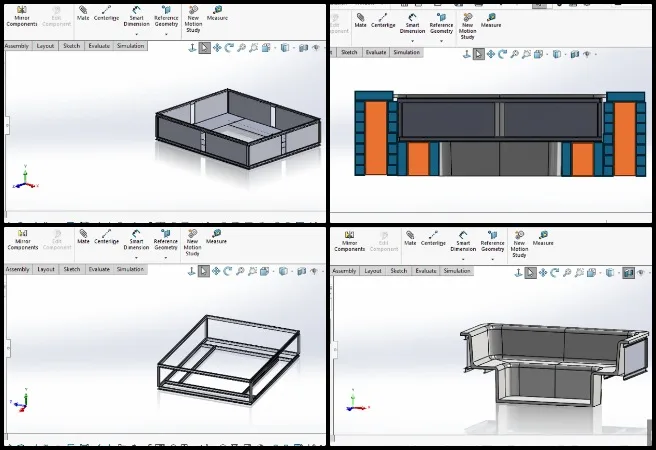
Shreyas Nagaraj (Design Engineer) made more updates to the City Center Dome Hub Connector Engineering and beams for the Duplicable City Center. He updated the model revisions progressing across multiple rows with hub connector updates for Row 7.1 and Row 7.2 being completed and the files were provided to Nikhil for integration into the assembly. He also reviewed the spreadsheet prepared by Nikhil for the Duplicable City Center project and provided input to help improve its usability with clearer documentation and worked on preparing the latest files for assembly integration for hub connector Row 9. This open source Duplicable City Center project exemplifies creating a sustainable world that benefits everyone. For more details, refer to the image below.
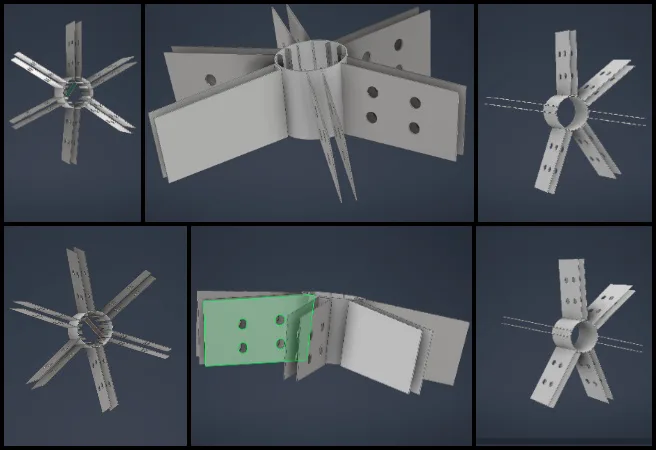
Vineela Reddy Pippera Badguna (Mechanical Engineer) continued contributing to the Duplicable City Center Water Catchment designs. This week was about updating the rainwater catchment and greywater system spreadsheets with new calculations and adjustments to improve accuracy and consistency. She cross-verified all numerical data to ensure precision and alignment with the existing documentation. She also reviewed various websites to identify potential areas for simplifying the greywater system and explored relevant sections in detail to gain a clear understanding of its structure and functionality. This open source Duplicable City Center project contributes to creating a sustainable world that benefits everyone. See the updated rainwater catchment data and design visuals below.

HIGHEST GOOD FOOD PROGRESS
 One Community is creating a sustainable world that benefits everyone through Highest Good food that is more diverse, more nutritious, locally grown and sustainable, and part of our open source botanical garden model to support and share bio-diversity:
One Community is creating a sustainable world that benefits everyone through Highest Good food that is more diverse, more nutritious, locally grown and sustainable, and part of our open source botanical garden model to support and share bio-diversity:
This week, the core team continued working on the Master Tools, Equipment, and Materials and Supplies List for the Large-scale Garden, Botanical Garden, and other Highest Good Food components. The team made comparison lists between the Master Tools, Equipment, Materials/Supplies document and the Botanical Garden document. Additionally, cross-comparisons were completed between the Large-scale Garden and Orchard documents, as well as the Orchard and Botanical Garden documents. The Highest Good Food initiative is a key component of One Community’s open source plans, focused on creating a sustainable world that benefits everyone and exemplifying the organization’s commitment through innovative design and implementation. Below are some images showcasing this work.
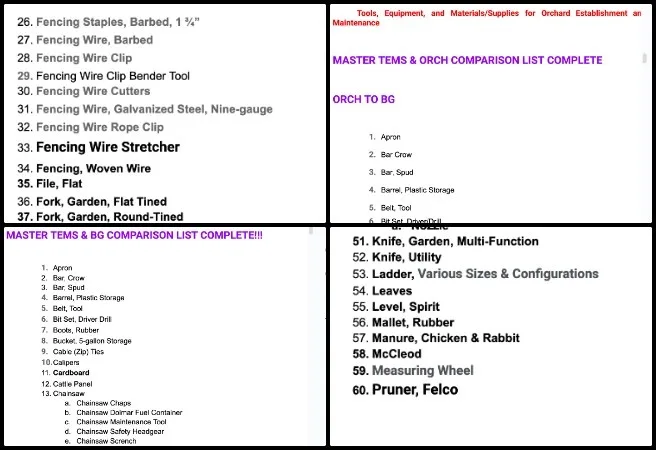
Anuneet Kaur (Administrator) continued her new focus on the design of the Transition Food Self-sufficiency Plan components of the Highest Good food initiative. Anuneet completed the Omnivore Rice, Omnivore Pasta, Omnivore Potato, Transition Kitchen, and Omnivore Sweet Potato webpages. She researched the most sustainable options for paints, urinals, and windows by reviewing scholarly articles and compiling relevant statistics for the graphic creation process. She ensured all team members were included in the live blog task and identified any missing names. Additionally, Anuneet reviewed Yulin’s infographic on sustainable research and provided detailed feedback. She fulfilled administrative responsibilities by editing summaries and collages for the Highest Good Society, Highest Good Education, and Core Teams, and reviewed fellow admin submissions for completeness and accuracy. The One Community model of creating a sustainable world that benefits everyone, exemplified by sustainably built classrooms and housing studies like these, fosters lasting global impact. Her recent contributions are featured in the collage below.
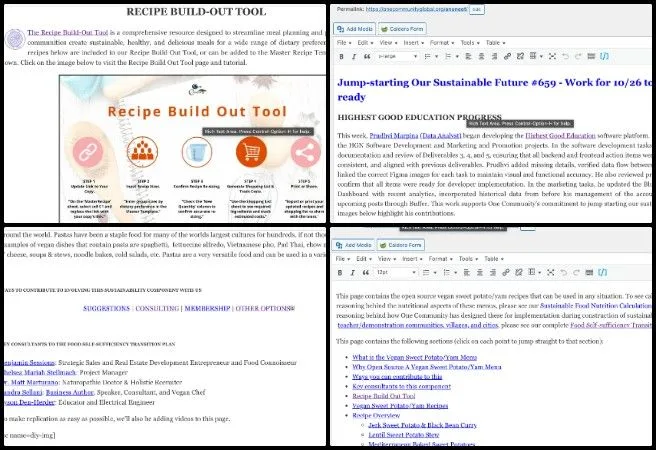
Chelsea Mariah Stellmach (Project Manager) continued her new focus on the Transition Food Self-sufficiency food and inventory tracking software plans. She met with the core team to discuss ideas for improving the mockups and adding additional screens, particularly surrounding the integration of the Master Recipe Tool spreadsheet’s functionality. Chelsea shared the feedback from that discussion and coordinated the next round of mockups after establishing contact with the UX/UI designer, Ravi, to integrate into Figma. As an essential aspect of One Community’s open source goals, the Highest Good Food initiative supports creating a sustainable world that benefits everyone. The following images provide a view of her contributions.
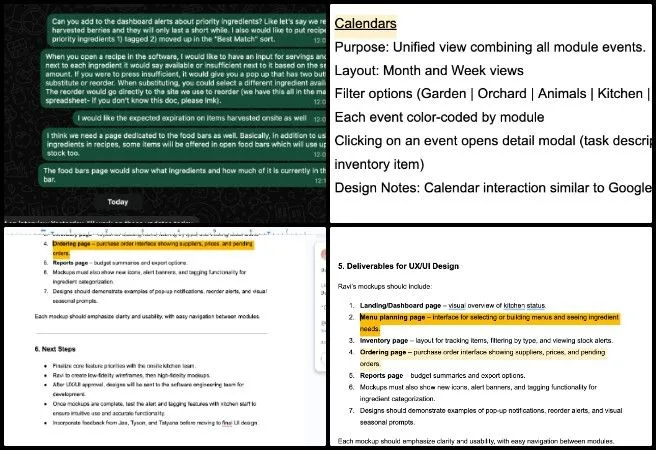
Dirgh Patel (Mechanical Engineer) continued assisting with the Climate Battery design updates. Dirgh focused on refining the greenhouse HVAC analysis report by expanding calculations, explanations, and formatting for clarity and technical accuracy. He began by developing calculations for the greenhouse’s external HVAC system using an energy balance approach, identifying heating, cooling, and ventilation requirements for different operating cases across all months. Dirgh then revised the report to improve explanation flow and added clear descriptions of equations so readers could follow the logic behind each step. Additional edits were made in the heating and cooling requirements section, where rules of thumb and practical guidance were included for different temperature scenarios. He inserted contextual explanations before equations and added supporting visuals and images for reference. Dirgh included explanations for each section, concept, and title, ensuring that all references and calculation photos were properly attached within the document. One Community’s open source mission is powerfully reflected in the Highest Good Food initiative, which is focused on creating a sustainable world that benefits everyone. See the images below to review this week’s updates.
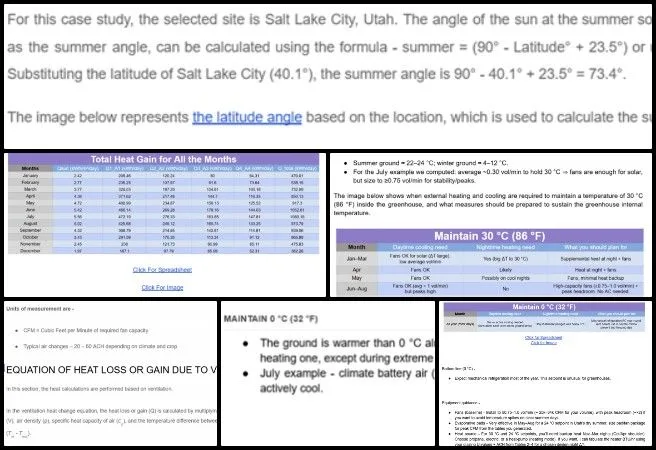
Falguni Sakpal (Volunteer Architectural Designer and Planner) focused on initiating render development for the Aquapini and Walipini Master Plan of the Highest Good Food initiative. She also worked on related Website Content Updates tasks. Falguni began by reviewing the original CAD files, exporting layered drawings, and collecting visual references from Pinterest to establish a consistent material and color language for the renders. She organized the base plan, elevation, and section drafts, setting up files for the first round of render development. Coordination with Jae and Shivangi clarified the approach and confirmed the starting point for visualization tasks. The Highest Good Food initiative is a key part of One Community’s open source platform, focused on sustainable and participatory development while creating a sustainable world that benefits everyone. See below for pictures related to this work.
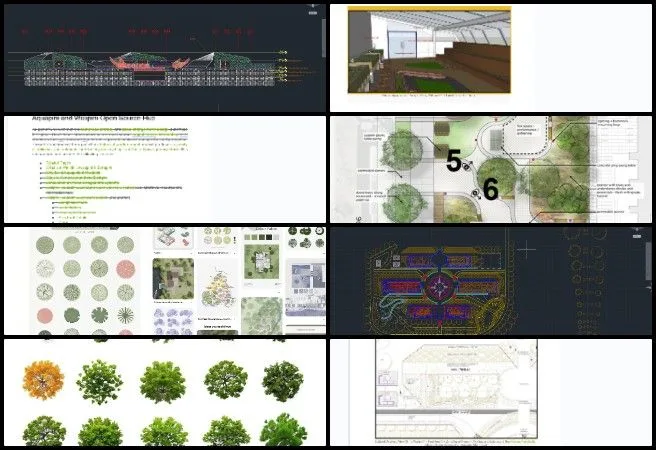
Gayatri Pandkar (Architect) continued writing content for the various components of the Aquapini and Walipini aspects of the Highest Good Food initiative. Gayatri worked on writing the detailed report on the Walipini 3 structure, covering the key design features, people spaces, and various sustainable systems incorporated within the greenhouse. She added rendering views of the different areas to illustrate the design and spatial layout, and included a legend and elements used in the visuals. In addition, she prepared the conclusion section, summarizing the elements within the greenhouse. The Highest Good Food initiative is a key part of One Community’s open source platform, focused on sustainable and participatory development while supporting creating a sustainable world that benefits everyone. Visual examples from her work are presented below.
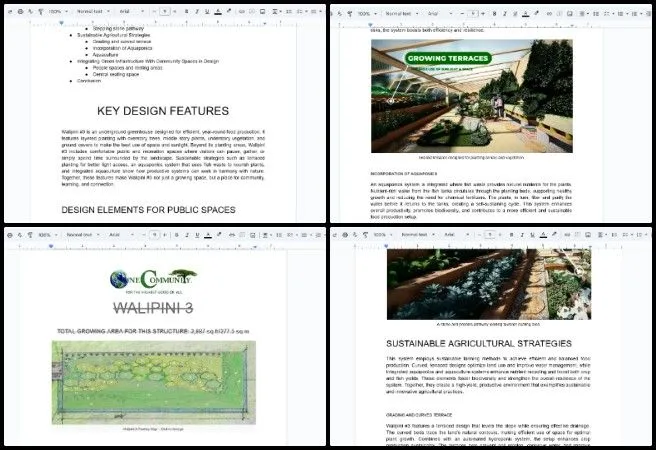
Japneet Kour (Volunteer Architect) continued contributing to the Highest Good Food initiative. She worked on Walipini 1, the Frost-Free Arid Desert House, focusing on adding trees and plants according to the layout provided. Japneet referred to the planting map to identify suitable tree and plant species for both floor and slope areas, ensuring each was placed accurately as indicated in the plan. She studied various species to understand their environmental suitability, growth characteristics, and relationship to the surrounding landscape while maintaining consistency with the design intent and site context. The Highest Good Food initiative is a key part of One Community’s open source platform, focused on sustainable and participatory development while supporting creating a sustainable world that benefits everyone. Visual examples from her work are presented below.

Jay Nair (BIM Designer) continued developing the Aquapini and Walipini Planting and Harvesting documents. He worked on calculating the lighting energy requirements for Walipini 1, ensuring that the data aligns with project standards and current fixture specifications. Jay also continued developing the concept for a user interface design for the lighting energy calculator software, focusing on organizing features that would simplify future greenhouse lighting analysis. The Highest Good Food initiative is a key part of One Community’s open source platform, focused on sustainable and participatory development while supporting creating a sustainable world that benefits everyone. See below for pictures related to this work.
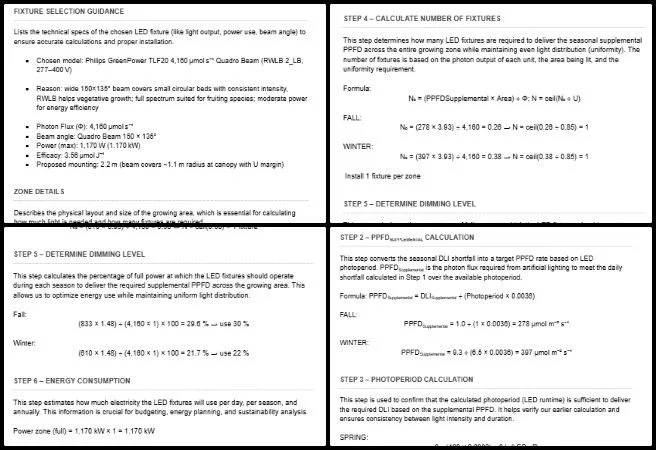
Pallavi Deshmukh (Software Engineer) continued working on the Aquapini and Walipini Planting and Harvesting web details. She developed new content for Blog #659, integrated feedback from teammates, and updated the Walipini 2 page with content from Silin and contributions from Junyi Shi, including revisions to text, links, and images before submitting the updated version for Jae’s review. Pallavi completed the Walipini 2 work and began updating Walipini 1 and Zenapini 2 using content from Gayatri Pandkar. Pallavi also completed one interview and submitted the related details. In alignment with One Community’s open source objectives, the Highest Good Food project integrates the concept of creating a sustainable world that benefits everyone into a larger vision of regenerative living. Her contributions are highlighted in the collage below.
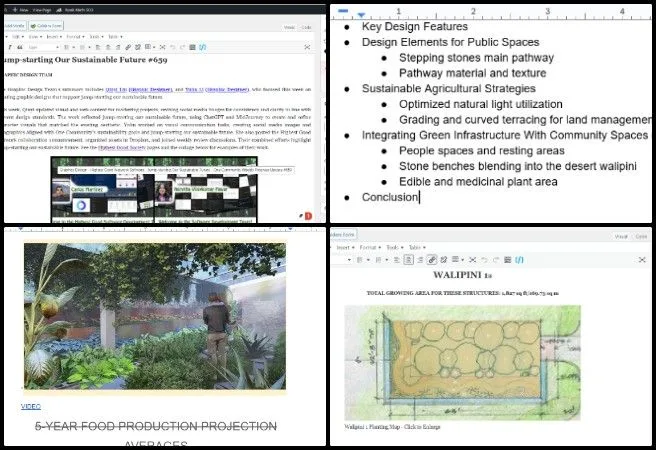
Ravi Kumar Sripathi (Software Engineer) continued developing the Food Procurement and Storage software platform, enhancing features related to inventory tracking, recipe management, and food utilization. He implemented dashboard alerts for priority ingredients, such as recently harvested items with short shelf lives, to support timely use and reduce waste. Recipes containing these ingredients are now tagged and ranked higher in the “Best Match” sort. Ravi also added a servings input to each recipe page, enabling automatic evaluation of ingredient quantities as “available” or “insufficient” based on stock levels. When an ingredient is marked insufficient, a pop-up offers two options: “substitute” or “reorder.” The substitute option lets users select an alternative ingredient from available stock, while the reorder option links directly to the corresponding supplier through the master spreadsheet. He further integrated expiration tracking for onsite-harvested items to improve freshness visibility and began developing a dedicated “Food Bars” page to display ingredients and quantities currently used in open food bars, ensuring more accurate inventory tracking outside recipes. These updates improved both functionality and user experience, enhancing the One Community model of creating a sustainable world that benefits everyone. Below are images related to his work.
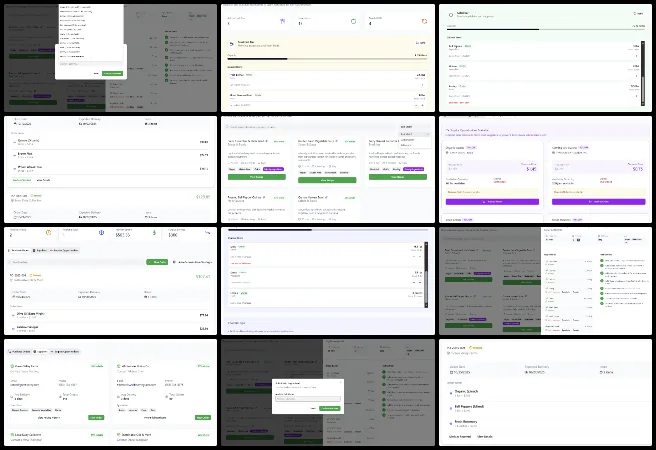
Shivangi Varma (Volunteer Architectural Designer and Planner) continued the redesign of the Highest Good Food overall presentation, currently focused on the Aquapini and Walipini masterplan render. She finalized the shadows, beveling, textures, and depth of the landscape elements, added detailed plants to the structures, and made final edits to the masterplan render. The Highest Good Food initiative plays a leading role in One Community’s open source platform by promoting sustainable and participatory development, focused on creating a sustainable world that benefits everyone. Below are visuals highlighting this work.
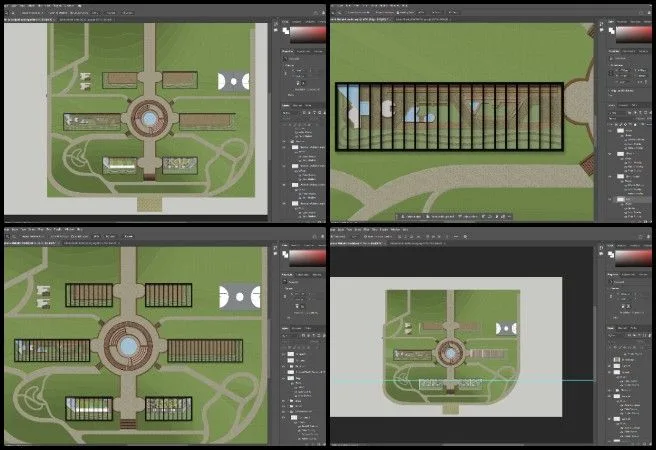
HIGHEST GOOD ENERGY PROGRESS
 One Community is creating a sustainable world that benefits everyone through Highest Good energy that is more sustainable, resilient, supports self-sufficiency and includes solar, wind, hydro and more:
One Community is creating a sustainable world that benefits everyone through Highest Good energy that is more sustainable, resilient, supports self-sufficiency and includes solar, wind, hydro and more:
- Learn about the open source sustainable-energy foundations: Solar, Hydro, and Wind
- Explore our research into the most sustainable products and companies for saving water and energy: Insulation, Eco-laundry, Lightbulbs and Light Bulb Companies, Doors and Door Companies, Windows and Window Companies, Toilets, Faucets and Faucet Accessories, Urinals, and more.
This week, the core team continued contributing to the Highest Good Energy initiative. They met with Chelsea to discuss inventory software requirements and reviewed several Highest Good Energy documents, making necessary link updates in the Solar Energy Microgrid report. The team also reviewed Earthbag Village information and reordered the Construction Document spreadsheet to align with Michaela’s recommendations. The Highest Good Energy initiative plays a leading role in One Community’s open source platform by promoting sustainable and participatory development focused on creating a sustainable world that benefits everyone. Below are images related to this project.

HIGHEST GOOD EDUCATION PROGRESS
 One Community is creating a sustainable world that benefits everyone through Highest Good education that is for all ages, applicable in any environment, adaptable to individual needs, far exceeds traditional education standards, and more fun for both the teachers and the students. This component of One Community is about 95% complete with only the Open Source School Licensing and Ultimate Classroom construction and assembly details remaining to be finished. With over 8 years of work invested in the process, the sections below are all complete until we move onto the property and continue the development and open sourcing process with teachers and students – a development process that is built directly into the structure of the education program and everything else we’re creating too:
One Community is creating a sustainable world that benefits everyone through Highest Good education that is for all ages, applicable in any environment, adaptable to individual needs, far exceeds traditional education standards, and more fun for both the teachers and the students. This component of One Community is about 95% complete with only the Open Source School Licensing and Ultimate Classroom construction and assembly details remaining to be finished. With over 8 years of work invested in the process, the sections below are all complete until we move onto the property and continue the development and open sourcing process with teachers and students – a development process that is built directly into the structure of the education program and everything else we’re creating too:
This week, Prudhvi Marpina (Data Analyst) continued developing the Highest Good Education software platform, focusing on Phase 4: marketing, promotion, and administrative activities. He reviewed documentation and videos related to Level 1 and Level 2 testing, created a developer account, reviewed PRs, and ensured that developers updated their PR titles according to project standards. Prudhvi also added new tasks and integrated updated Figma images into the Phase 4 document. In marketing, he updated the BlueSky Buffer schedule for social media posts, created documentation and a tutorial video for the social media process, and updated the Social Media Master Dashboard with this week’s analytics. Additionally, he reviewed administration team summaries, provided feedback, and edited Blog #659 for publication. Through these activities, he supported One Community’s commitment to creating a sustainable world that benefits everyone. The images below highlight his contributions.
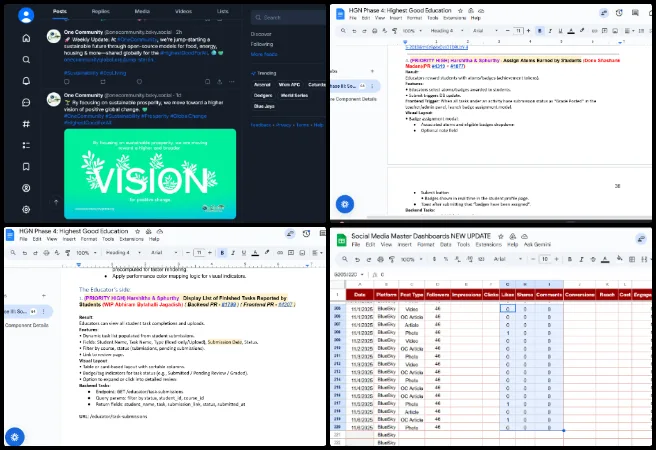
HIGHEST GOOD SOCIETY PROGRESS
 One Community is creating a sustainable world that benefits everyone through a Highest Good society approach to living that is founded on fulfilled living, the study of meeting human needs, Community, and making a difference in the world:
One Community is creating a sustainable world that benefits everyone through a Highest Good society approach to living that is founded on fulfilled living, the study of meeting human needs, Community, and making a difference in the world:
This week, the core team completed over 40 hours managing volunteer work reviews, handling emails, overseeing social media accounts, supporting web development, identifying new bugs, and integrating bug fixes for the Highest Good Network software, as well as interviewing and onboarding new volunteer team members. They also produced and integrated the video above, highlighting how creating a sustainable world that benefits everyone serves as the foundation of One Community’s broader mission. The following images showcase highlights of this work.

Jaiwanth Reddy Adavalli (Project Manager) continued developing the Job Applicants page and key components of the Highest Good Network, tracking updates in the software team management documents to assign, monitor, and support task status. He worked on the Phase 1 and Phase 2 Dashboards by testing multiple components in the HGN software. He tracked updates in software team management documents to support task management. As a member of the pull request review team, he reviewed submissions from the volunteer team assigned to him. This work supports One Community’s commitment to creating a sustainable world that benefits everyone. The images below highlight his contributions.
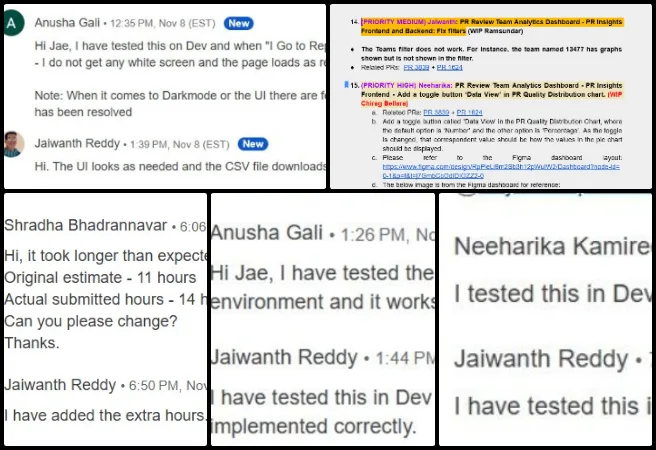
Rajrajeshwari Gangadhar Sangolli (Data Analyst) continued working on Google Ads management and strategy evolution of the Highest Good Network. She worked on HGN software testing by reviewing multiple pages, testing buttons, and verifying functionalities, identifying two new errors while confirming other processes were functioning as expected. She examined weekly performance data, applied Google recommendations, and analyzed performance changes compared to previous weeks. This work contributes to One Community’s commitment to creating a sustainable world that benefits everyone. She made corrections to several links based on feedback from the HGN bugs report and recorded a video demonstrating the identified issues for cross-verification with Jae before adding them to the report. She created and logged four new tasks in Google Sheets based on Jae’s feedback. Rajrajeshwari also tested various pages of HGN Phase 2 using different accounts, reviewed charts and data points, assessed progress, and checked for pull requests that were ready to merge. Additionally, she tested dark mode availability across pages, reviewed different PRs, and designed a new chart for inclusion in the software interface. This project supports One Community’s commitment to creating a sustainable world that benefits everyone. The images below highlight key aspects of her work.
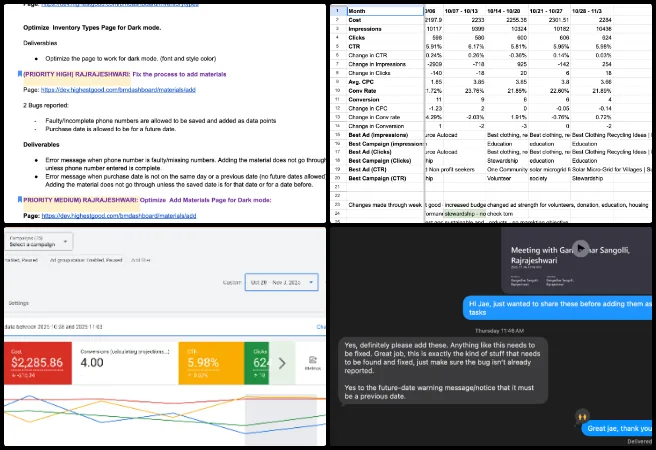
Yagna Reddy Badvel (Data Analyst and Team Administrator) continued working on the Summary Dashboards and Weekly Report page on the Highest Good Network. He focused on Phase 2 tracking and administration while also completing his weekend admin responsibilities. He connected with Jae to clarify the tracking process and next steps, reviewed all Phase 2 tabs to monitor contributor activity, and noted that most items were in New or Work In Progress (WIP) status. He followed up with teammates who had missing or delayed submissions to maintain consistent progress and communication. Over the weekend, he also reviewed team folders, verified that summaries and media were properly submitted, and ensured all materials were ready for the final review cycle. This work supports One Community’s commitment to creating a sustainable world that benefits everyone. The images below highlight his contributions.
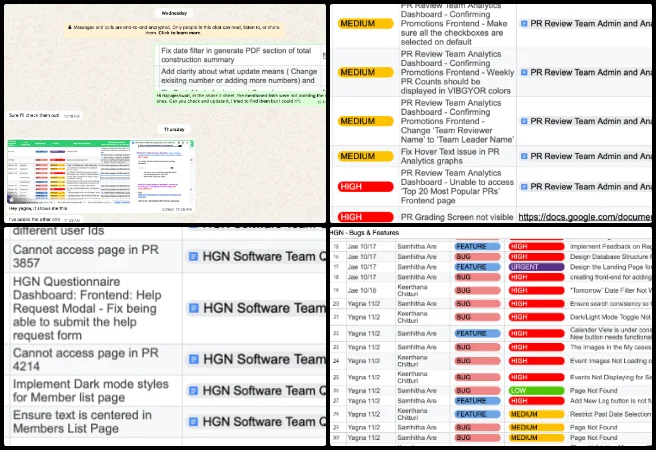
ADMINISTRATION TEAM
The Administration Team’s summary, which covers their work on the Highest Good Network, was managed by Prudhvi Marpina (Data Analyst) and includes Anusha Gali (Software Engineer), Ashutosh Mishra (Software Engineer), Divanshu Bakshi (Team Admin), Indra Anuraag Gade (Software Engineer and Team Administrator), Keerthana Chitturi (System Administrator), Mridul Bhushan (Volunteer Project Strategy Analyst and Team Administrator), Neeharika Kamireddy (Data Analyst), Olawunmi “Ola” Ijisesan (Administrative and Management Support), Olimpia Borgohain (Data Analyst and Team Administrator), Priyanshi Sharma (Data Analyst and Team Administrator), Rachna Malav (Data Analyst), Rajeshwari Bhirud (Administrator), Rishi Sundara (Quality Control Engineer and Team Administrator), Rishitha Adepu (Administrator), Sai Suraj Matta Veera Venkata (Business Data Analyst), Sayantan Paul (Volunteer Frontend Tester and Software Team Administrator), and Sudarshan Raju Chintalapati Venkata (Data Analyst). The Administration Team supports the Highest Good Network, a tool designed to track and measure progress while developing systems that contribute to creating a sustainable world that benefits everyone. Through administrative support, documentation, testing, training, recruiting, analytics, and content management, the team helps advance this mission, aligning with One Community’s vision of building a replicable and sustainable future model.
This week, Anusha focused on Level 2 software testing and QA for the HGN software, completing orientation tasks and documenting results for multiple pull requests. Ashutosh finalized the 3D avatar frontend for the virtual assistant and improved chatbot testing and lip-sync performance. Divanshu created a detailed Mastodon analytics guide, automated raw data updates using Python, and added new action items to improve dashboard accuracy. Indra updated the Code Crafters blog, managed Twitter/X analytics, and began exploratory analysis for engagement trends using machine learning. Keerthana handled administrative duties, reviewed submissions, and updated tracking sheets. Mridul finalized Moonfall Team summaries for Blog #659, conducted HGN Phase 2 testing, and prepared his collaborator announcement. Neeharika managed task assignments, tested pull requests, and completed admin reviews. Ola managed Pinterest scheduling, analytics, and supervised PR review managers. Olimpia updated LinkedIn analytics, resolved admin comments, and planned next week’s posts. Priyanshi tested multiple HGN Phase 2 pages and PRs, verified charts and filters, and reviewed mock dashboards.
Rachna reviewed old tasks and SEO pages, while Rajeshwari continued as Blog #659 Administrator, updating Binary Brigade content, optimizing SEO, and testing BM Dashboard features. Rishi tested several pull requests, resolved conflicts, and finalized SEO updates for Blog #658. Rishitha updated bio administration, added new Threads data to the Social Media Master Dashboard, and scheduled an interview. Sai Suraj enhanced the Social Media Master Dashboard, improved visuals, managed content scheduling, and completed SEO adjustments. Sayantan performed Level 1 testing, began Level 2 training for job posting features, and reviewed the Skye team. Sudarshan managed the Alpha Software Team blog, reviewed PRs for Phase 2, created new feature and bug tasks, validated dashboard performance, and improved BM Dashboard functionality. To learn more about how this work supports One Community’s vision of creating a sustainable world that benefits everyone, visit the Highest Good Society and Highest Good Network pages. Highlights of their contributions are shared below.

GRAPHIC DESIGN TEAM
The Graphic Design Team’s summary includes Qinyi Liu (Graphic Designer) and Yulin Li (Graphic Designer), who focused this week on creating graphic designs that support creating a sustainable world that benefits everyone.
This week, Qinyi worked on design and web-related tasks for marketing and promotion. She designed a logo based on project specifications, created bio images, announcements, and related website pages, revised previously requested posters to match current branding, and supported creating a sustainable world that benefits everyone through consistent digital presentation. Yulin revised five infographics and six volunteer announcements, posted the software team collaboration announcement, managed assets in Dropbox, and joined weekly reviews. Their combined efforts highlight creating a sustainable world that benefits everyone. See the Highest Good Society pages and the collage below for examples of their work.
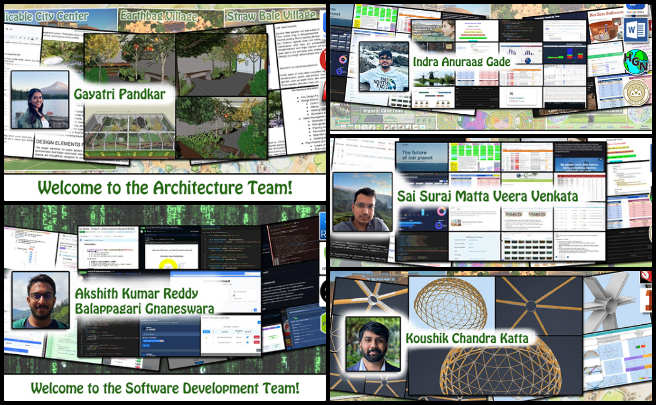
HIGHEST GOOD NETWORK PROGRESS
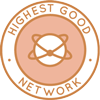 One Community is creating a sustainable world that benefits everyone through open source Highest Good Network® software that is a web-based application for collaboration, time tracking, and objective data collection. The purpose of the Highest Good Network is to provide software for internal operations and external cooperation. It is being designed for global use in support of the different countries and communities replicating the One Community sustainable village models and related components.
One Community is creating a sustainable world that benefits everyone through open source Highest Good Network® software that is a web-based application for collaboration, time tracking, and objective data collection. The purpose of the Highest Good Network is to provide software for internal operations and external cooperation. It is being designed for global use in support of the different countries and communities replicating the One Community sustainable village models and related components.
This week, the core team tested HGN pull requests and confirmed 11 fixed PRs. This effort highlights One Community’s commitment to creating a sustainable world that benefits everyone. The following items were not fixed: PR Review Team Analytics Dashboard – Create Routes (PR3838); displaying the “Contributors Report” (PR3958); HGN Questionnaire Dashboard – linking the survey form to gather data (PR4009); and updating the font color on the Reports page in Dark Mode (PR3948). The team also reviewed assigned badges for “Tester One” and logged 40 hours testing the “New Max” and “30 Hours in Week” badges. They communicated with a volunteer regarding issues in PR BM Dashboard – Change .css to .module.css in /BMDashboard/WeeklyProjectSummary/ActualVsPlannedCost (#3879 and #3885), investigated and documented the issue with the Total Construction Summary page for PR grouped_bar_graph_named_paid_labor_cost_frontend (#3420), and were unable to fully test Create Application/Job Posting Landing Page: Make improvements (PR3997) and Application/Job Posting Landing Page: Add What We Do section (#4030) due to missing data on the Main branch. This work strengthens One Community’s mission of creating a sustainable world that benefits everyone. See the Highest Good Society and The Highest Good Network pages, and the collage below, for an overview of the team’s contributions.

ALPHA SOFTWARE DEVELOPMENT TEAM
The Alpha Software Team, working on the Highest Good Network software, was managed by Lin Khant Htel (Frontend Software Developer). The team also includes Carlos Martinez (Software Developer) and Nikita Kolla (Full Stack Developer). The Highest Good Network software is a key part of sustainable and free-shared eco-solutions, helping track and measure progress toward creating a sustainable world that benefits everyone. It supports social architecture, construction, production, and maintenance processes that contribute to the open source project and resilient ecosystems. Designed to be portable and scalable, the software is well suited for off-grid and sustainable living communities. This project reflects One Community’s open source commitment to advancing the idea of creating a sustainable world that benefits everyone.
Lin reviewed PR #1873, tested it locally, and identified that some test cases failed, requiring follow-up with developers. She also reviewed weekly submissions, including summaries, photos, and videos, and coordinated team activities. Carlos continued work on the Total Construction Summary page, focusing on adapting all components for dark mode compatibility. After submitting a pull request, he resolved SonarQube errors to maintain code reliability, improve readability, and support a consistent and high-quality code base. Nikita refactored code for the Core Team members’ tasks by reorganizing functions, removing redundant logic, and enhancing readability to improve performance and minimize potential errors. She also addressed statistical accuracy issues that impacted the reliability of reported data, ensuring the results aligned with expected outputs. See the Highest Good Society and Highest Good Network pages and the collage below for examples of how this work contributed to the idea of creating a sustainable world that benefits everyone.

BINARY BRIGADE SOFTWARE DEVELOPMENT TEAM
The Binary Brigade Team, presenting their work on the Highest Good Network software, was managed by Nikhil Routh (Software Engineer) and included Kanishk Agarwal (Software Engineer), Deep Shah (Software Engineer), Ramsundar Konety Govindarajan (Software Engineer), Harsha Rudhraraju (Software Engineer), Xinyi Zhou (Developer), Sourabh Bagde (Software Developer), Taariq Mansurie (Full-Stack Developer), Sumedh Kumar (Full-Stack Developer), Aswin “Tony” Kanikairaj (Software Engineer), and Amalesh Arivanan (Software Engineer). The Highest Good Network software is our tool for managing and objectively measuring progress, ensuring that all contributions are tracked and aligned with our mission, modeling, and creating a sustainable world that benefits everyone.
This week, Amalesh worked on integration tests for the reasonSchedulingController by validating API behavior, resolving merge conflicts, and fixing failing test cases as part of PR #1873. He also developed the Phase 2 Summary Dashboard, which includes four KPI tiles, a weekly task completion chart, and a date range filter (4-, 8-, and 12-week options), ensuring responsive design, backend integration, and input validation. This work contributes to One Community’s commitment to creating a sustainable world that benefits everyone. Aswin completed Phase 3 – Resource Request Form (PR #4333), focusing on front-end validation, inline error handling, and success confirmation messages. He enhanced the user interface with drag-and-drop upload functionality, image preview, and dark-mode compatibility, verifying responsiveness and performing extensive testing across devices. Deep implemented the Dynamic Equipment Data Display and Selection feature, replacing static content with dynamic API-driven data connected to the backend. He reviewed MongoDB collections, aligned the frontend with Figma designs, and ensured accurate retrieval of equipment information with improved data consistency. Harsha developed the “Hits and Applications for Each Job” feature, improving responsiveness, dark mode compatibility, and user interface adaptability. She integrated backend logic for fetching job data, enhanced error handling, and refined the chart’s transitions and accessibility for a smoother user experience. This effort supports One Community’s mission of creating a sustainable world that benefits everyone.
Kanishk refined the registration status feature by ensuring persistence across reloads, fixing session-storage issues, and validating data integrity after multiple sign-ups. He also audited and improved the community calendar implementation, fixing the category filter to ensure entries update dynamically upon selection. Nikhil focused on migrating legacy CSS files to CSS Modules across multiple components, including Community Portal, BM Dashboard, and Teams. This work reflects One Community’s dedication to creating a sustainable world that benefits everyone. He investigated MongoDB timeouts and login time-tracking issues in production while coordinating with the team to discuss backend requirements and task distribution. Ram enhanced the PR Review Team Analytics Dashboard by auto-selecting users in the promotion confirmation table and correcting color and layout inconsistencies in the PR counts section. He resolved pre-commit hook issues, merged UI fixes under PR #4346, and began investigating filter functionality issues in the PR Insights section. This contribution aligns with One Community’s focus on creating a sustainable world that benefits everyone.
Sourabh refined the Slashdot scheduler by improving validation, user feedback, and layout responsiveness. He implemented popup notifications for missing fields, enforced date validations, and enhanced edit workflows with better state management and responsive UI for a smoother scheduling experience. Sumedh resolved a major crash on the Equipment List page (PR #4336) by fixing invalid table structures and unsafe data access. He triaged multiple bugs, including the Member Check-in search bar issue, and began initial development of the Material Usage Modal as a new feature after team discussions. This effort contributes to One Community’s long-standing commitment to creating a sustainable world that benefits everyone. Taariq handled multiple maintenance and development tasks, resolving merge conflicts and debugging backend integrations. He enhanced the “Assign Lesson Plan” feature by adding an edit option and tracking user actions while also improving summary email accuracy and recording a walkthrough video showcasing recent updates. Xinyi fixed layout and data visibility issues in the Global Distribution and Project Status Overview map and noted the need for a backend API build. She enhanced the “Tools by Availability” chart by adding a multi-select filter dropdown, improving design consistency, and ensuring full functionality in both light and dark modes. See the Highest Good Society and Highest Good Network pages for more about how this work models creating a sustainable world that benefits everyone. The collage below shows images of their work.
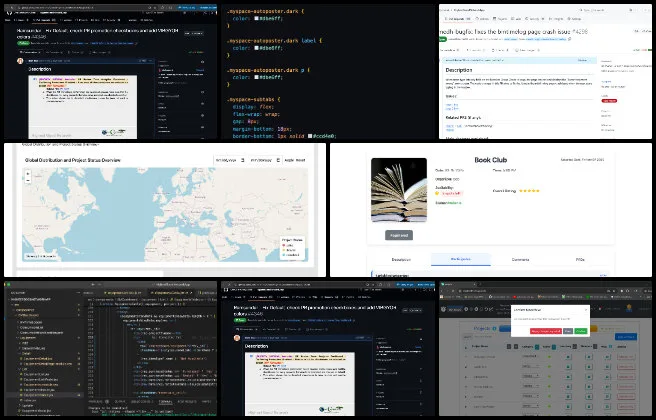
BLUE STEEL SOFTWARE DEVELOPMENT TEAM
The Blue Steel Software Team, working on the Highest Good Network software, was managed by Divanshu Bakshi (Product Manager) and includes Linh Huynh (Software Engineer), Humemah Khalid (Software Engineer/Backend Developer), Som Ramnani (Software Engineer), and Sheetal Mangate (Software Engineer). This week, Linh completed development of the Event Management Page (Organizer View) for Phase 3, supporting creating a sustainable world that benefits everyone. His work included restructuring the project by removing the old EventManagementPage directory, creating the new EventPageOrganizer folder, and updating the route to community portal activity event pages. He set up a mock event API using localStorage to support data persistence for event details, description changes, status updates, rating adjustments, date selection, and schedule management. He added media upload capability to the Description section, implemented new ID generation using crypto.randomUUID() to resolve security warnings, finalized CSS modules for all components, updated the routes file to align with the new structure, and confirmed that the page renders based on the activityId from the URL. This work plays a part in One Community’s broader aim of creating a sustainable world that benefits everyone.
Humemah worked across multiple repositories on merge conflicts and backend updates. She resolved conflicts and integrated changes for several pull requests in the HighestGoodNetworkApp and HGNRest repositories, including work related to PRs #4203, #3991, and #1658. This work supports One Community’s overall mission to create a sustainable world that benefits everyone. She reviewed merged updates and tested the code to confirm that existing functionality remained stable. Som focused on the Phase 3 HGN Software Development project, fixing an issue where the dashboard view did not render correctly when accessed from the profile section. He identified that the route was incorrectly set to the community portal instead of the dashboard path and applied the fix to ensure correct rendering. This work is a key step in One Community’s plan for creating a sustainable world that benefits everyone. Som also updated the pull request description with details of the route change and addressed a task related to selecting featured badges, updating the pull request summary, and adding a demo video to document the update. Sheetal focused on end-to-end testing for the Reddit autoposter, verifying the workflow from authentication through content submission to ensure functional components behaved as expected. She resolved issues related to token handling and scheduling logic and completed code cleanup by removing redundant logic and improving readability to support stability and maintainability of the automation, further supporting creating a sustainable world that benefits everyone. The collage below shows images of their work.

CODE CRAFTERS SOFTWARE DEVELOPMENT TEAM
The Code Crafters Team, covering their work on the Highest Good Network software, was managed by Indra Anuraag Gade (Software Engineer and Team Administrator) and includes Ajay Naidu (Software Engineer), Akshith Kumar Reddy Balappagari Gnaneswara (Software Engineer – Full Stack), Chaitanya Swaroop Kumar Allu (Software Engineer), Sanjeev Raichur (Software Engineer), Shradha Bhadrannavar (Software Engineer), Sphurthy Satish (Software Engineer), and Vivek Chandra (Software Engineer). The Highest Good Network software is how we’ll manage and objectively measure our progress in creating a sustainable world that benefits everyone through our social architecture, construction, production, and maintenance efforts, while supporting widespread and lasting eco-lifestyle access.
This week, Ajay enhanced the Teams page by enabling views for all team members, as well as active and inactive segments, adding logic to fetch and display counts for each category. This contribution is a reflection of One Community’s efforts to create a sustainable world that benefits everyone. He introduced clear user feedback during data retrieval and empty states with styled “Loading” and “No Team Found” messages, added a loading indicator next to each team name, and refined category switching so lists update correctly when moving between all, active, and inactive views. These updates addressed failing test cases and ensured that new states, styles, and data flows integrate smoothly with current functionality. This work supports One Community’s overall mission to create a sustainable world that benefits everyone.
Akshith continued work on the Phase 4 Educator Certification Management backend task, resolving errors in the controller and router and setting up the frontend structure to integrate with backend components. This work supports One Community’s larger initiative focused on creating a sustainable world that benefits everyone. Chaitanya stabilized and optimized the MailChimp replacement backend, adding validations, reducing database usage, exploring Azure Blob Storage for scalability, and ensuring idempotent cron-job workflows with error handling. Sanjeev implemented new event creation functionality in the Community Portal’s Participation Reports section, adding Redux actions, a modal interface with input fields, state management, and toast notifications, enabling administrators to create events directly from the UI. This contribution helps move forward One Community’s purpose of creating a sustainable world that benefits everyone.
Shradha completed testing and verification for PR #3826 and PR #3851, validating navigation, data updates, UI consistency, and resolving Node version and package conflicts. This effort is part of One Community’s ongoing journey toward creating a sustainable world that benefits everyone. Sphurthy implemented analytics functionality to track student performance and engagement metrics, creating a StudentMetrics model, a background job for daily metric refreshes, and REST endpoints integrated with existing Express and Mongoose patterns. Vivek updated the model and API to include the resolved_by field, ensured proper task status tracking, fixed frontend dropdown issues, and added the “Resolved Task” button. These contributions strengthen One Community’s mission and commitment to creating a sustainable world that benefits everyone. See the collage below for an overview of this team’s work.

DEV DYNASTY SOFTWARE DEVELOPMENT TEAM
The Dev Dynasty Team’s summary, covering their work on the Highest Good Network software, was managed by Prem Vora (Software Developer) and includes Adithya Cherukuri (Volunteer Software Engineer), Aditya Gambhir (Software Engineer), Deekshith Kumar Singirikonda (Developer), Manvitha Yeeli (Software Engineer), Neeraj Kondaveeti (Software Engineer) and Vamsidhar Panithi (Software Engineer). The Highest Good Network software is how we’ll manage and objectively measure our processes for creating a sustainable world that benefits everyone through our social architecture, construction, production, and maintenance processes.
This week, Adithya completed backend email functionality for booking notifications, then worked on the Job Posting Analytics feature by creating a data model for enhanced role-based visualization, developing the GET/Timeline API route, implementing role-based filtering for developer positions, handling date ranges, and finalizing documentation. Aditya worked across backend and frontend features for the BM Dashboard, reviewed PR 1879, raised PR 4324 to add project, date range, and issue-type filters for the Issues Breakdown Chart, added debounced API calls, reset buttons, dark mode support, and responsive layouts, optimized backend aggregation queries, added compound indexes and caching, centralized error logging with Sentry, refactored axios calls through a wrapper, and improved validation, performance, and API reliability. Deekshith worked on a React component that analyzes event attendance data by converting event timestamps, parsing percentage values, grouping events by time of day, filtering based on user-selected date ranges, and preparing structured analytics to display insights on attendance behavior in the user interface.
Manvitha implemented a timer feature for the student portal dashboard, adding a popup interface with play, pause, and stop controls, backend timer controller, MongoDB model, history and statistics endpoints, and integrated database connections through PR #4340 and PR #1886. This effort is part of One Community’s ongoing journey toward creating a sustainable world that benefits everyone. Neeraj refactored the PR Reviews Insights feature by converting CSS files to module-based styling, updated JSX paths and layouts for dark mode, improved spacing on the PR Action Done graph, and enhanced the Resource Management Dashboard with a new Add New Log modal and updated CSS hierarchy. Prem resolved issues in the “Upcoming Events” section, refined date-handling logic, fixed event mapping, implemented pagination, and aligned organizer and attendee details with database values. This work exemplifies One Community’s ongoing efforts toward creating a sustainable world that benefits everyone.
Vamsidhar improved tag functionality on the Lesson List page, adding visible tag chips, localStorage persistence, dark mode support, refined styling, prevented duplicates, and resolved React warnings. These contributions strengthen One Community’s mission and commitment to creating a sustainable world that benefits everyone. See the Highest Good Society and Highest Good Network pages for more on how this relates to our mission of creating a sustainable world that benefits everyone. Explore some of the team’s work in the collage below.
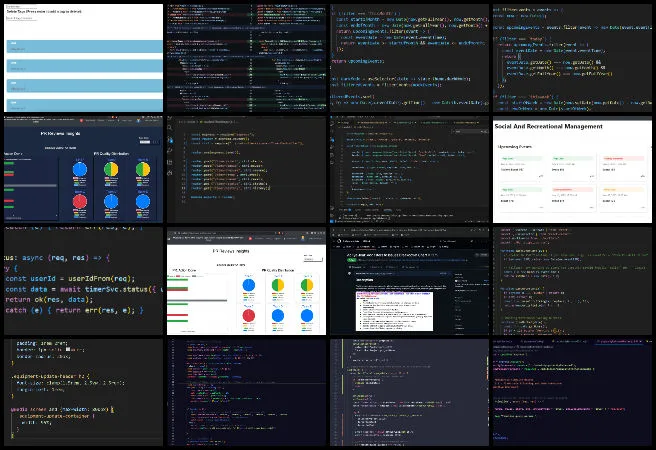
EXPRESSERS SOFTWARE DEVELOPMENT TEAM
The Expressers Team’s summary, which covers their work on the Highest Good Network, was managed by Rahul Trivedi (Software Engineer) and includes Casstiel Pi (Software Engineer), Layne Taylor (Software Engineer), and Meenashi Jeyanthinatha (Full-Stack Developer). This contribution supports One Community’s goal of creating a sustainable world that benefits everyone.
This week, Casstiel resolved a legend color inconsistency in the project chart. Department colors had been dynamically generated, which caused the same department to appear in different colors depending on filters. Casstiel fixed this by assigning Plumbing, Electrical, Carpentry, and Welding fixed colors using a predefined map, ensuring consistent color mapping in the chart and legend. ESLint still needs to be run on the updated file, and an official Git PR will be created for review and approval. This contribution supports One Community’s goal of creating a sustainable world that benefits everyone.
Layne focused on the “Add Material” button functionality on the Materials page. This work exemplifies One Community’s ongoing efforts toward creating a sustainable world that benefits everyone. After discussions with Jae, the button was updated to open a modal with a text search instead of a dropdown. The search displays matching results or allows adding a new material, linking to the AddMaterial page with an SKU and QR code generator derived from the manufacturer and product name to reduce input errors. She also researched inventory management and SKU generation methods and created a generic modal with a text input and search button that retrieves backend material data. This work supports One Community’s goal of creating a sustainable world that benefits everyone.
Meenashi refined email functionality, improving question order handling and data integrity for form submissions, while testing uploads via the Dropbox shared public folder. Validation was added for required fields, and front-end payloads now preserve question order. Pending tasks include additional form validation, permission checks, Collab Ads updates, and enhanced question forms. Rahul addressed naming convention issues and cleaning tasks in the src/Reports folder and analyzed unresolved merge conflicts with Yiyun Tan, while also supporting team management through reviewing summaries, videos, and meetings. These combined efforts strengthen One Community’s mission of creating a sustainable world that benefits everyone. See the Highest Good Society and Highest Good Network pages for more on how this work contributes to creating a sustainable world that benefits everyone. The collage below showcases the team’s work.
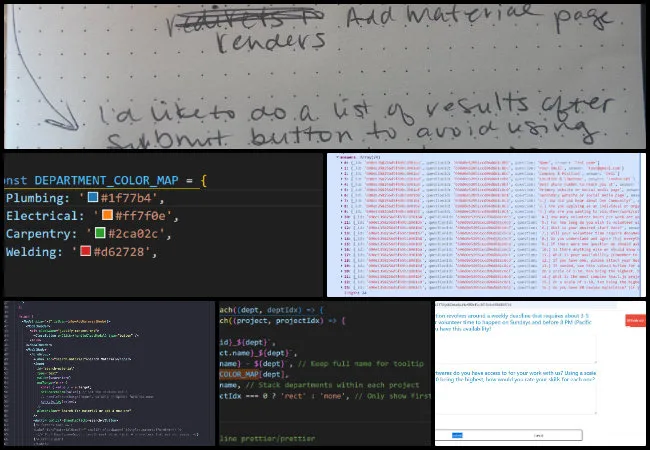
LUCKY STAR SOFTWARE DEVELOPMENT TEAM
The Lucky Star Team’s summary, covering their work on the Highest Good Network, was managed by Keerthana Chitturi (System Administrator). The team includes contributions from Abhishek Jain (Software Engineer), Aryan Rachala (Software Engineer), Chirag Bellara (Software Engineer), Dipti Yadav (Software Engineer), Durga Venkata Praveen Boppana (Software Engineer), Ganesh Karnati (Software Engineer), Shashank Madan (Software Engineer), Shravya Kudlu (Software Development Engineer), Sohail Uddin Syed (Software Engineer), Veda Bellam (Software Engineer), and Venkataramanan Venkateswaran (Software Engineer). Their work supports One Community’s goal of creating a sustainable world that benefits everyone through cross-functional software development.
This week, Abhishek focused on resolving technical issues across both frontend and backend pull requests, addressing SonarQube findings and merge conflicts. This effort is part of One Community’s ongoing journey toward creating a sustainable world that benefits everyone. He completed backend fixes and made progress on frontend validation, though GitHub runner performance slowed testing. Aryan enhanced the PR Review Team Analytics Dashboard by updating the PR Quality Distribution charts to display team member counts and coordinated with Bhavpreet Singh to restore a removed route. Chirag resolved the Exceptional Category color issue on the PR Analytics dashboard, fixed non-functioning URLs, and began implementing the “Data View” functionality. Dipti developed a new Support Portal, creating SupportLogin and SupportDashboard components with CSS modules, routing, and authentication functionality. Durga fixed a server date retrieval issue and implemented the initial Education Portal Report page design. These efforts support creating a sustainable world that benefits everyone.
Ganesh improved the “Most Expensive Issues” feature by updating Node.js, resolving compatibility and merge conflicts, aligning frontend and backend code, and ensuring proper dropdown filters, layout, labeling, and responsiveness. This work exemplifies One Community’s ongoing efforts toward creating a sustainable world that benefits everyone. Shashank modified the API for multi-atom assignment, developed frontend modals, and resolved merge conflicts. Shravya implemented and tested core functionality for Phase 4 of tagged logs in Young Learner Support Frontend, refining structure and styling to deliver a working version of the feature. Sohail resolved merge conflicts in two pull requests and enhanced email functionality by ensuring weekly threads remain unique with date-appended subjects. Veda replaced the legacy job form builder, improved form refresh behavior, integrated callbacks for question management, and fixed dark mode issues in the calendar component. This work supports One Community’s larger initiative focused on creating a sustainable world that benefits everyone.
Venkataramanan addressed multiple frontend and backend issues, resolving internal server errors, fixing layout and color inconsistencies, and improving readability across Weekly Summary Report and Leaderboard pages. He collaborated with Jae for testing and verification before merging changes. Together, these updates demonstrate significant progress on the Highest Good Network platform, strengthening One Community’s mission and commitment to creating a sustainable world that benefits everyone. See the Highest Good Society and Highest Good Network pages to learn more about how this work supports creating a sustainable world that benefits everyone. The collage below highlights the team’s work for the week.
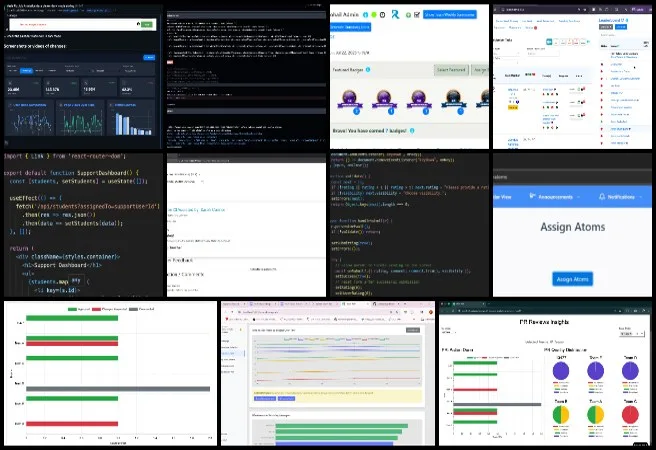
MOONFALL SOFTWARE DEVELOPMENT TEAM
The Moonfall Team’s summary, which covers their work on the Highest Good Network, was managed by Bhavpreet Singh (Software Engineer) and includes Aayush Shetty (Software Engineer), Alisha Walunj (Software Engineer), Mani Shashank Marneni (Software Engineer), Ramakrishna Aruva (Software Engineer), Sai Krishna (Software Engineer), Sree Pujitha Kakani (Software Engineer), Sudheesh Thuralkalmakki Dharmappa Gowda (Full Stack Developer), Uha Kruthi (Software Engineer), and Zhicheng Tong (Software Engineer). Their efforts advance One Community’s mission of creating a sustainable world that benefits everyone, promoting open-source collaboration, ecologically responsible innovation, and holistic global progress.
This week, Bhavpreet worked on three different features, including styling updates for the teaching children groups feature to improve screen adaptability and add dark mode support, implementing dark mode for browsable lesson plans for interface consistency, and building the backend for lesson plan submission with error handling, in addition to completing the assigned managerial feature. This work contributes to One Community’s commitment to creating a sustainable world that benefits everyone.. Sai progressed on the actual cost donut chart, completing backend integration with data sources, resolving MongoDB retrieval issues, and adjusting frontend rendering to align visuals with design and data expectations. Zhicheng enhanced the log visualization module by refining component structure, virtualization logic, and caching behavior for improved responsiveness with large datasets, while investigating the BM Dashboard “Something went wrong” error by tracing request and response flows and initiating local tests. Alisha advanced the Learner Knowledge Evolution View across backend and frontend layers by restructuring models, refining aggregation pipelines, updating routes, and configuring endpoints, while also contributing to the Collaborative Lesson Plan Creation backend by updating schemas and resolving draft approval inconsistencies. This work supports One Community’s overall mission to create a sustainable world that benefits everyone.
Uha improved the Injury Severity chart, converting it into a full-width responsive layout, refactoring JSX and CSS, adding dark mode styling, optimizing filters, and resolving layout spacing issues. Ramakrishna continued developing WebSocket functionality for the disconnected timer feature by analyzing connection flows, testing multiple scenarios, and resolving conflicts in pending pull requests. This work plays a part in One Community’s broader aim of creating a sustainable world that benefits everyone. Sudheesh progressed on the material utilization ratio chart for the Phase 2 Summary Dashboard, implementing backend API routes with mock data, developing and styling frontend components, and connecting them to backend endpoints for real-time visualization. Sree completed dark mode enhancements for the BM Dashboard by updating scoped CSS modules, applying theme variables, resolving merge conflicts, and verifying consistent rendering across subpages, while also finalizing another pull request with functional testing. This work is a key step in One Community’s plan for creating a sustainable world that benefits everyone.
Aayush fixed the BM Dashboard Tools form dropdown issue by debugging API-related problems, updating affected files, verifying changes locally, and documenting the bug analysis. Mani developed a stacked horizontal bar graph for the “Reason of Stoppage of Tools” in the Phase 2 Summary Dashboard, building a backend controller to aggregate and normalize tool stoppage data and implementing a Chart.js frontend component to display categorized results with corresponding color coding. These combined contributions demonstrate significant progress on the Highest Good Network platform. Visit the Highest Good Society and Highest Good Network pages for more on how this work supports creating a sustainable world that benefits everyone through open-source development and globally accessible resources. The collage below showcases the major accomplishments completed by the team this week.
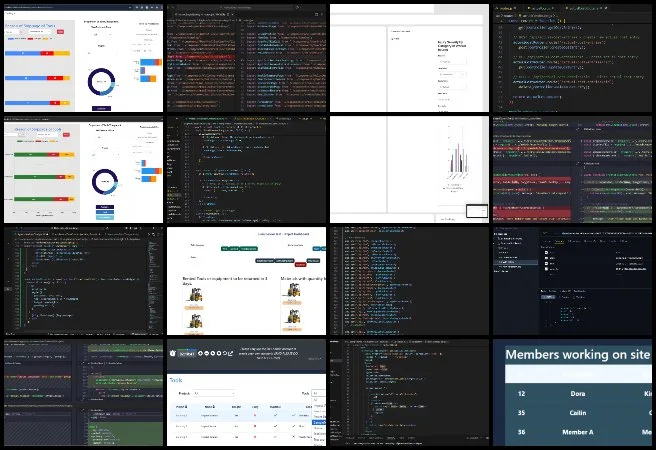
REACTONAUTS SOFTWARE DEVELOPMENT TEAM
The Reactonauts Team’s summary, covering their work on the Highest Good Network, was managed by Sai Suraj Matta Veera Venkata (Business Data Analyst) and Akshay Jayaram (Software Engineer). The team includes Aseem Deshmukh (Software Developer), Diya Wadhwani (Software Developer), Guna Pranith Reddy Cheelam (Software Developer), Namitha Vijaykumar Pawar (Software Engineer), Peterson Rodrigues dos Santos (Full Stack Developer), Siva Putti (Software Engineer), Sri Satya Venkatasai Siri Sudheeksha Vavila (Software Engineer), Suparshwa Patil (Software Engineer), Tom Linn (Software Engineer), and Ujjwal Baranwal (Full-stack Software Developer). The Highest Good Network software helps manage and objectively measure progress by focusing on demonstrating creating a sustainable world that benefits everyone. It supports social architecture, construction, production, and maintenance processes to build sustainable and thriving ecosystems.
This week, Akshay implemented dark mode functionality for the CPDashboard component by referencing the ReviewsInsight component, integrating Redux state for theme detection, and updating styles for dynamic adaptation. He also hosted the weekly Reactonauts team meeting, coordinated team activities, monitored pull requests, and submitted the weekly team review. This effort contributes to One Community’s long-standing commitment to creating a sustainable world that benefits everyone. Aseem improved the Planned vs Actual Cost Tracking graph by refining tooltips, adjusting label spacing, adding filters and a project list dropdown, and supporting dark mode, submitting PR 4354. Diya resolved multiple email and UI issues, restored the People Report task pie chart, improved layout alignment and visual consistency, and standardized the Project–Task section using CSS modules. Guna addressed frontend issues on the listings home page and the community portal activity log, while Namitha implemented the FAQ section on the Job Application Listing Page and submitted PR 4342 for the Analytics Page frontend updates. Peterson fixed validation issues on the Teams page (PR 4329). This work contributes to One Community’s commitment to creating a sustainable world that benefits everyone.
Siva restricted past date selection in the community portal calendar and verified the implementation (PR 4338). Sudheeksha implemented dark mode for the Member list page, fixed Daily Logging Button links in the BMDashboard, and completed related functionality. This work reflects One Community’s dedication to creating a sustainable world that benefits everyone. Suparshwa identified and fixed minor codebase bugs, researched optimization techniques to improve model inferencing efficiency, and performed load testing while documenting improvement areas. Tom worked on validation messages for the Activities List calendar; the code compiles, but changes are not yet reflected, and debugging is ongoing. Ujjwal developed backend APIs for editing names and measurements, updated history views, and fixed dark mode and formatting issues in the Total Construction Summary page, submitting PR 4356. See the Highest Good Network and Highest Good Society pages to learn more about how this work supports modeling creating a sustainable world that benefits everyone. See below for the work done on demonstrating creating a sustainable world that benefits everyone.

SKYE SOFTWARE DEVELOPMENT TEAM
The Skye Team’s summary, covering their work on the Highest Good Network, was managed by Sayantan Paul (Frontend Tester and Software Team Administrator) and Anthony Weathers (Software Engineer). The team includes Julia Ha (Software Engineer), Lavanya Lahari Nandipati (Software Developer) and Marcus Yi (Software Engineer). The Highest Good Network software helps manage and objectively measure progress by focusing on creating a sustainable world that benefits everyone. It supports social architecture, construction, production, and maintenance processes to build sustainable and thriving ecosystems. This solution is portable, scalable, and ideal for off-grid or sustainable living communities – an example of creating a sustainable world that benefits everyone.
This week, Anthony worked on fixing permissions for viewing warning trackers and accessing the modal used to modify or add them, updating the permission list by removing one and reorganizing the others, and confirming the changes with stakeholders. This work contributes to One Community’s commitment to creating a sustainable world that benefits everyone. He continued implementing the blue square feature for PR#3978 within the User Profile’s issue blue square section, with references to plans removed from the wording. Anthony also performed additional testing for the email automation task while attempting to set up an iCloud email account to compare how emails are sorted across services, though he was unable to connect it through Gmail. He updated PR#3713 by revising its CSS styling to meet current project requirements. Julia created the backend to retrieve material costs for all projects, wrote unit tests for the API endpoints, tested them with Postman, updated the frontend to use the new endpoint, fixed related errors, ensured responsiveness and proper dark mode display, and submitted PRs #1888 and #4344. This effort supports One Community’s mission of creating a sustainable world that benefits everyone.
Lavanya reviewed and tested the Badge Assignment feature across the HighestGoodNetworkApp and HGNRest projects, verified backend connectivity and environment setup, validated API endpoints, and identified a mismatch where the frontend uses a POST request to /api/badge/assign while the backend only provides a PUT route with a userId parameter, documenting the issue and recommending alignment. This work reflects One Community’s dedication to creating a sustainable world that benefits everyone. She analyzed multiple badge-related pull requests to determine duplicates and dependencies, verified that PR#1479 covers the necessary badge and scheduler changes, confirmed that PRs #1479, #1394, #1395, #1477, and #1193 should be closed, and determined that her own PR#1829 should be reverted to maintain repository consistency. Marcus finalized and merged the pull request he had been working on from the previous week and returned to the X autoposter feature, which he had completed earlier but encountered issues locating due to lost Git commits. See the Highest Good Society and Highest Good Network pages for more on how this contribution advances One Community’s goals for creating a sustainable world that benefits everyone in the Highest Good Network open source hub. See the collage below for the team’s work.
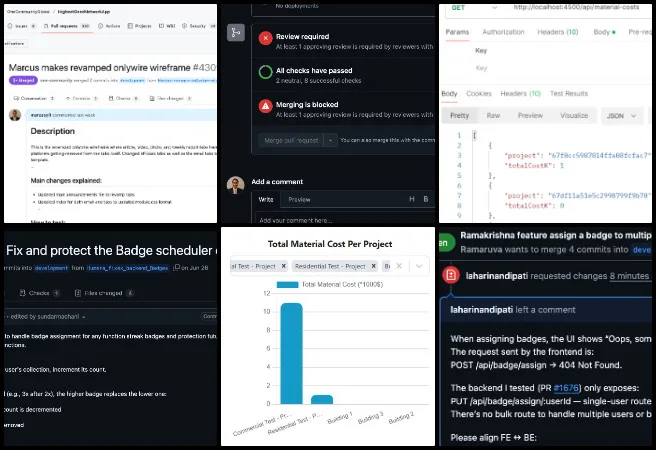
SOFTWARE PR REVIEW TEAM A-N
The PR Review Team’s summary for members with names starting A–N, managed by Neeharika Kamireddy (Data Analyst), highlights their contributions to the Highest Good Network software. This platform forms the foundation for measuring our results in creating a sustainable world that benefits everyone. Active team members included Abdelmounaim Lallouache (Software Developer), Carl Bebli (Software Developer), Maneesh Buddha (Software Developer), Nahiyan Ahmed (Full Stack Software Developer), and Nathan Hoffman (Software Engineer). They supported the project by reviewing all pull requests shared this week. Learn more about how the Highest Good Network tracks progress toward creating a sustainable world that benefits everyone in the Highest Good Network open source hub. The collage below showcases a compilation of this team’s work.
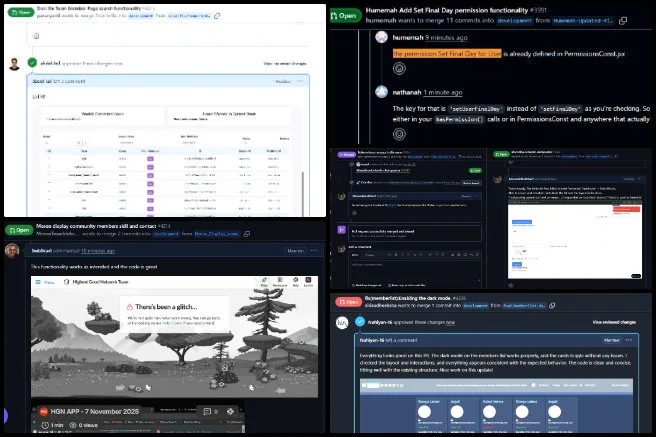
SOFTWARE PR REVIEW TEAM O-Z
The PR Review Team’s summary for team members with names starting from O–Z, covering their work on the Highest Good Network software, was managed by Jaiwanth Reddy Adavalli (Software Project Manager). The Highest Good Network software is a foundation for measuring our results in creating a sustainable world that benefits everyone. This week’s active members of this team were: Sriamsh Reddy (Software Engineer), Sundar Machani (Software Engineer), Vinay Krishna (Software Engineer), and Yiyun Tan (Software Engineer). They reviewed all the Highest Good Network PRs (Pull Requests) shared in this week’s update. Learn more about how the Highest Good Network measures progress toward creating a sustainable world that benefits everyone in the Highest Good Network open source hub. The collage below shows a compilation of the work from this team.
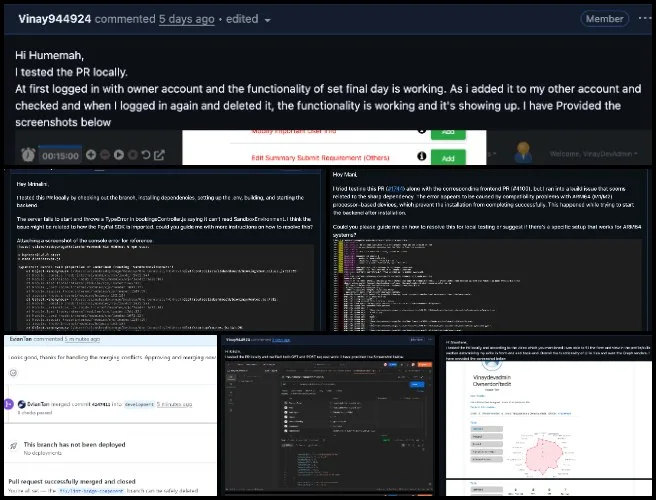
AND WE PRODUCED THIS WEEKLY UPDATES BLOG – CLICK HERE TO SUBSCRIBE
FOLLOW ONE COMMUNITY’S PROGRESS (click icons for our pages)










INVESTOR PAGES
OVERVIEW | LOCATION | FUNDING
GET INVOLVED
DONATE | WAYS ANYONE CAN HELP | MEMBERSHIP
CLICK HERE FOR ALL PAST UPDATES
Category: Community, One Community, Basics of One Community Tags: Duplicable City Center Hub, global sustainability, open source design, Education For Life progress, better is possible, for the highest good of all, transforming the global environment, solution based thinking, sustainable community building, Earthbag Village, Highest Good education, one community, Permaculture Communities, Highest Good housing, food forest, green living, resource based economy, Highest Good food, sustainable civilization building, permaculture, RBE, Highest Good society, creating global solutions, One Community Update, addressing climate change, Education for Life update, creating a new world paradigm, open source, grass roots sustainability, open source food, the betterment of society, non profit, self-sufficiency, ecological living, creating holistic transformational change, sustainable living, radical sustainability, solutions that create solutions, regenerative world building, open source sustainability, open source housing, One Community progress
 One Community
One Community
























































